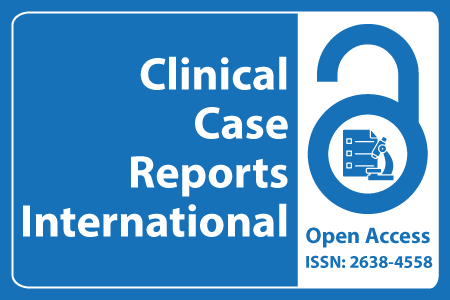
Journal Basic Info
- Impact Factor: 0.285**
- H-Index: 6
- ISSN: 2638-4558
- DOI: 10.25107/2638-4558
Major Scope
- Transplantation Medicine
- Psychiatry
- Radiology Cases
- Endocrinology
- Respiratory Medicine
- Leukemia
- Nuclear Medicine
- Molecular Biology
Abstract
Citation: Clin Case Rep Int. 2024;8(1):1672.DOI: 10.25107/2638-4558.1672
Cauda Equina Syndrome due to Arachnoiditis after Cesarean Section Under Combined Spinal-Epidural Anesthesia
Tsolaki M, Katsoulas I, Dardiotis E, Siokas V, Christodoulou S and Arnaoutoglou E
1 Department of Neurology, Medical School, Aristotle University of Thessaloniki, Greece
Medical school, Aristotle University of Thessaloniki, Greece
Department of Neurology, University Hospital of Larissa, School of Health Sciences, University of Thessaly, Greece
Department of Neurology, Laboratory of Neurogenetics, University of Thessaly, University Hospital of Larissa, Greece
Private Hospital Iassos, Larissa, Greece
Department of Anesthesiology, School of Health Sciences, University of Thessaly, University Hospital of Larissa, Greece
*Correspondance to: Magda Tsolaki
PDF Full Text Case Report | Open Access
Abstract:
This report presents a case of Cauda Equina syndrome resulting from toxic arachnoiditis caused by the administration of levobupivacaine with spinal-epidural anesthesia. A 31-year-old woman underwent a cesarean section using combined spinal-epidural anesthesia. However, post-surgery she developed Monoparesis of her right lower extremity along with numbness in the same area and saddle-shaped numbness on the right side of her genital area. Subsequent tests including computed tomography of the lumbar and thoracic spine the following day and non-contrast magnetic resonance imaging of the lumbar spine performed five days later did not reveal any abnormal findings. However, contrast-enhanced magnetic resonance imaging of the cervical, thoracic, and lumbar spine after 6 days showed pathological contrast uptake from the meninges in the right lateral part of the conus medullaris and cauda equina roots consistent with arachnoiditis, with no other findings from the spinal cord. The patient was treated with anti-inflammatory treatment with hydrocortisone sodium succinate from the first day and then with high doses of methylprednisolone in combination with a program of physical therapy, kinesiotherapy, and psychotherapy. Despite the above holistic therapeutic approach, 7 years later the patient continued to report weakness and numbness of the lower limb, inability to urinate and defecate, and saddle hypoesthesia in the genital area. Physicians should be aware of the potential neurologic complications of spinal-epidural anesthesia, the potentially toxic role of levobupivacaine in the arachnoid and conus medullaris, and the potential failure of corticoid and physical therapy, although these cases are very rare.
Keywords:
Cauda Equina Syndrome; Cesarian Section; Arachnoiditis; Anesthesia; Levobupivacaine
Cite the Article:
Tsolaki M, Katsoulas I, Dardiotis E, Siokas V, Christodoulou S, Arnaoutoglou E. Cauda Equina Syndrome due to Arachnoiditis after Cesarean Section Under Combined Spinal-Epidural Anesthesia. Clin Case Rep Int. 2024; 8: 1672.













